Abstract
The distal splenorenal shunt significantly improves 5-year survival from variceal bleeding in nonalcoholic (70%) compared to alcoholic (45%) cirrhosis patients. This study quantitates hemodynamic differences occurring in the first year after DSRS in 16 alcoholic compared to eight nonalcoholic patients. Portal venous perfusion was retained significantly better (p less than .01) by the nonalcoholic (seven of eight) than by the alcoholic (four of sixteen) patients. Mean liver blood flow (p less than 0.07), flow/unit liver volume (p less than .05), and flow required to perform a specific hepatocyte function (p less than 0.05) all increased significantly in the alcoholic compared to nonalcoholic group. Cardiac output increased significantly in the alcoholic patients (p less than 0.05), but was unchanged in the nonalcoholic patients. The alcoholic patients divided into two subsets, 11 who showed increase in flow (1082 +/- 260 to 1496 +/- 388 ml/min) and five who did not (1246 +/- 269 to 994 +/- 159 ml/min). The former had significantly (p less than 0.05) poorer hepatocyte function and had a significant (p less than 0.05) increase in flow/unit volume and flow/unit function at 1 year, which may have helped to maintain hepatocyte integrity. The latter, in parallel with the nonalcoholic patients, showed no significant change in these parameters and maintained a good functional hepatocyte mass. These data lead us to hypothesize that: 1) alcoholic liver injury has an increased risk of leading to loss of portal perfusion after DSRS, 2) as hepatocyte function falls, there is initial increase in hepatic arterial flow in alcoholic patients, triggered by increase in cardiac output, and 3) progressive injury and/or failure of the compensatory hemodynamic mechanism leads to earlier mortality in alcoholic patients. In contrast, the nonalcoholic cirrhosis patients preserve portal perfusion and maintain liver blood flow, both quantitatively and qualitatively, with retained hepatocyte function and improved survival.
Full text
PDF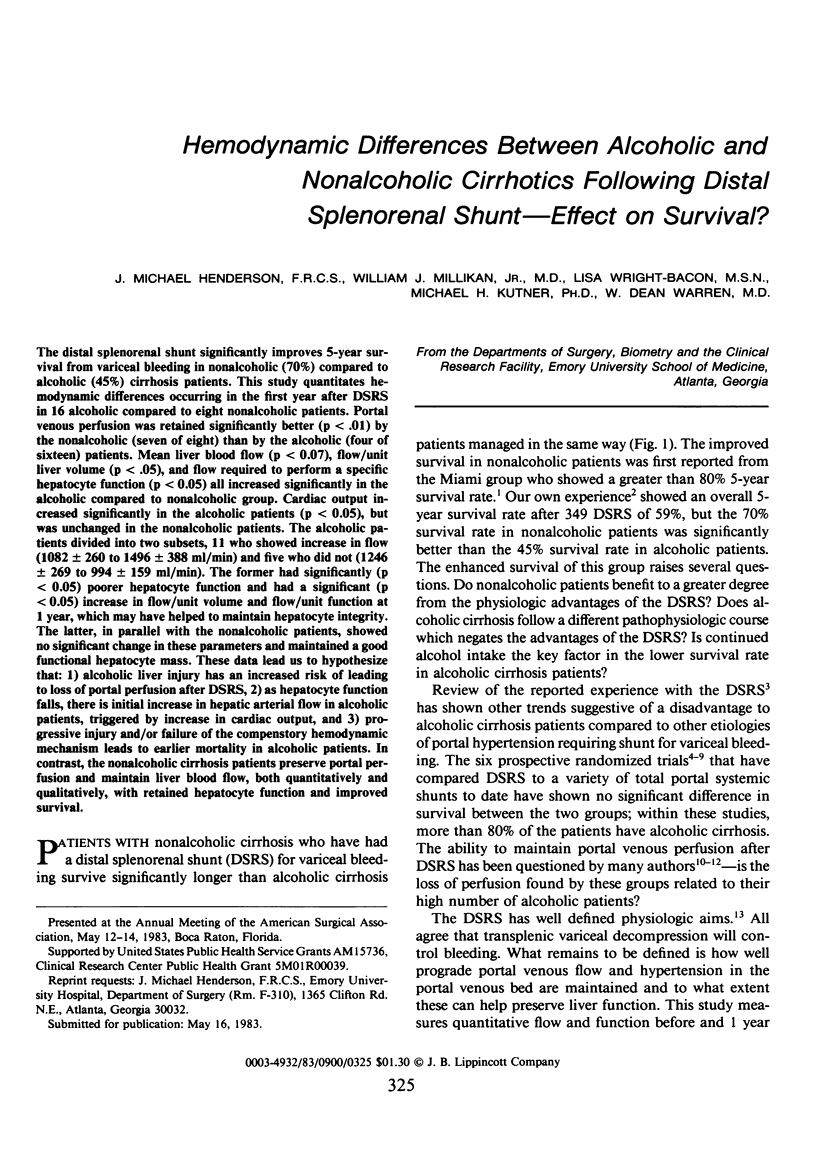
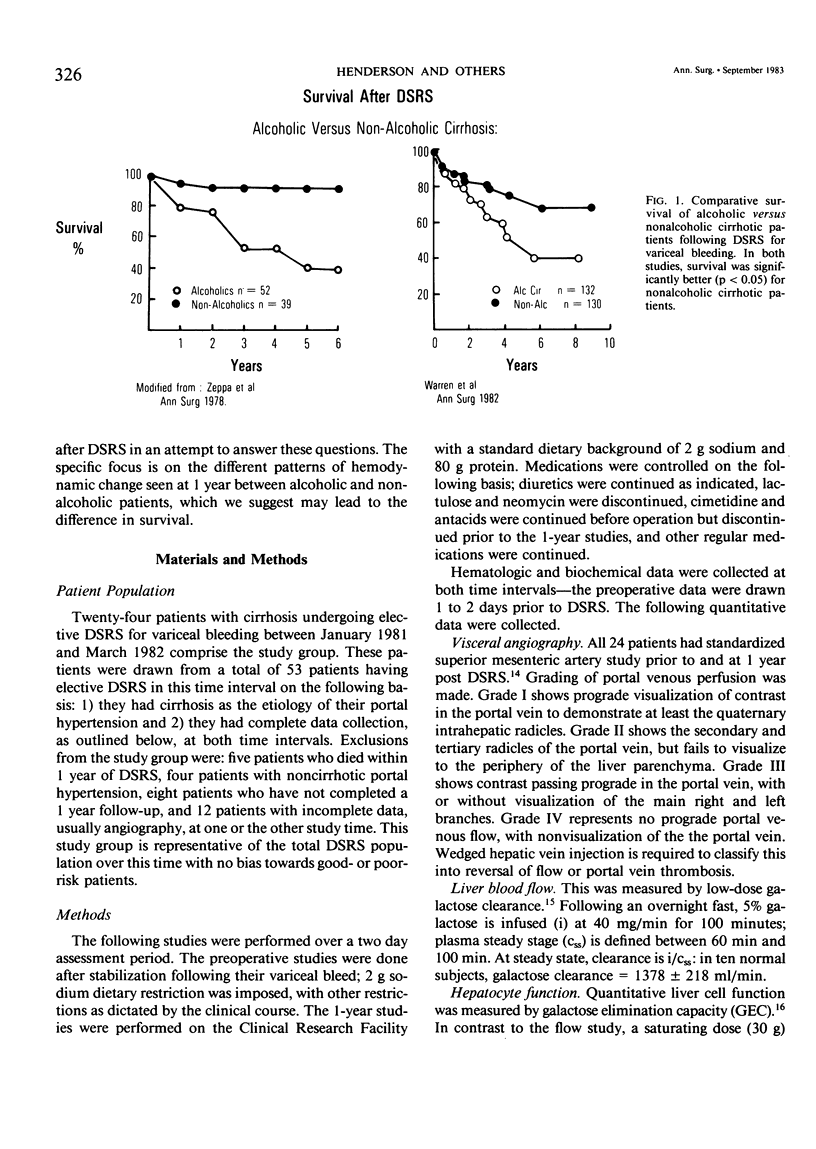
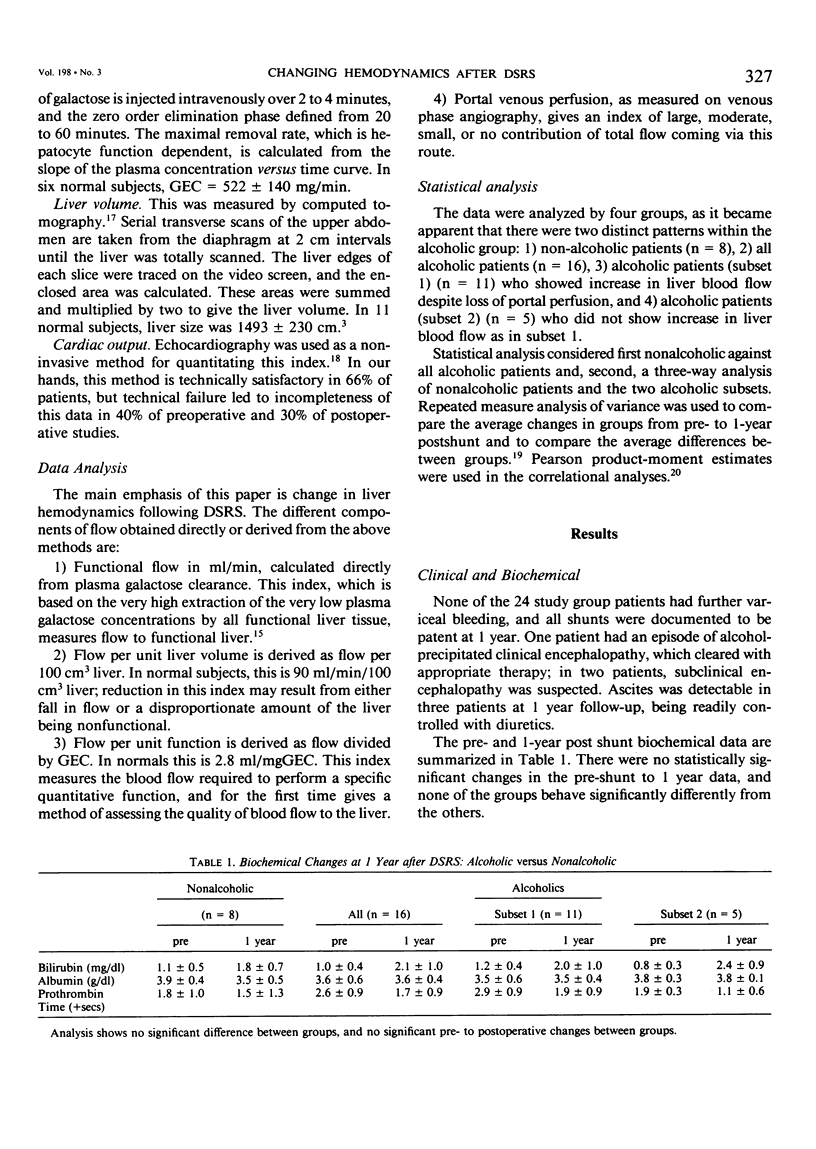

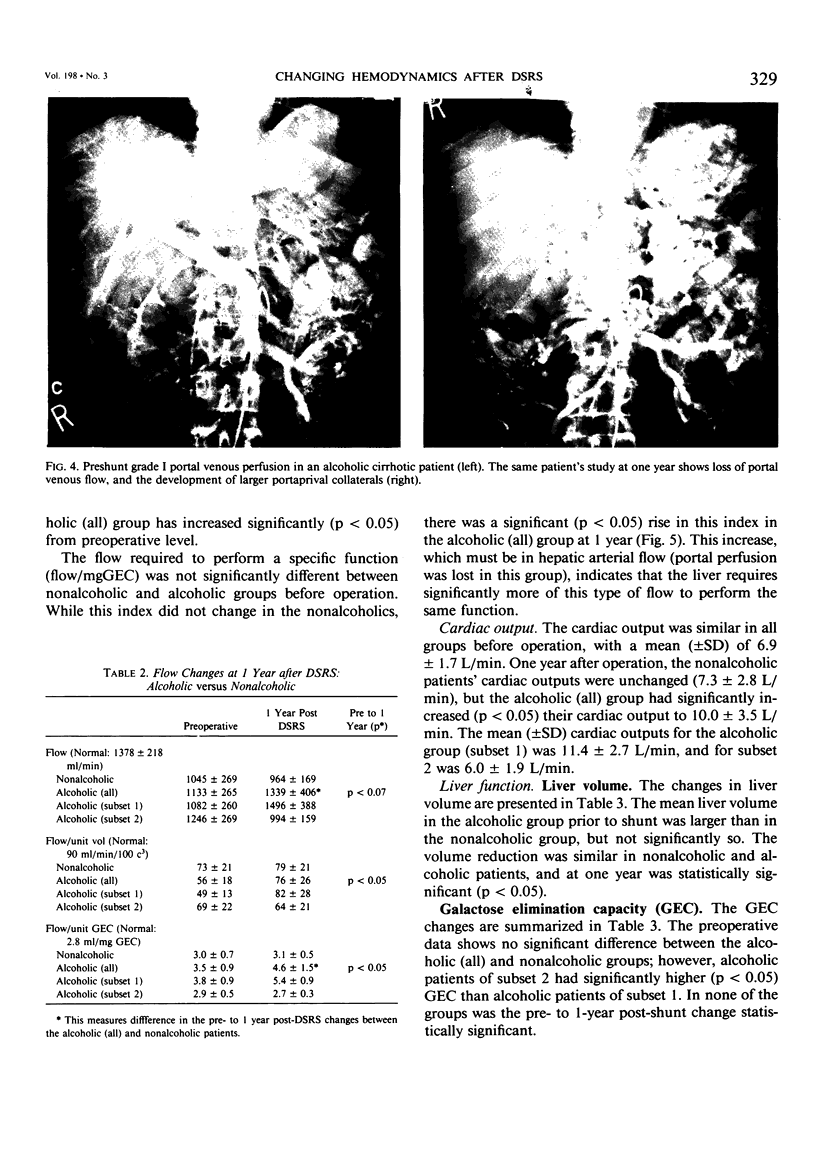
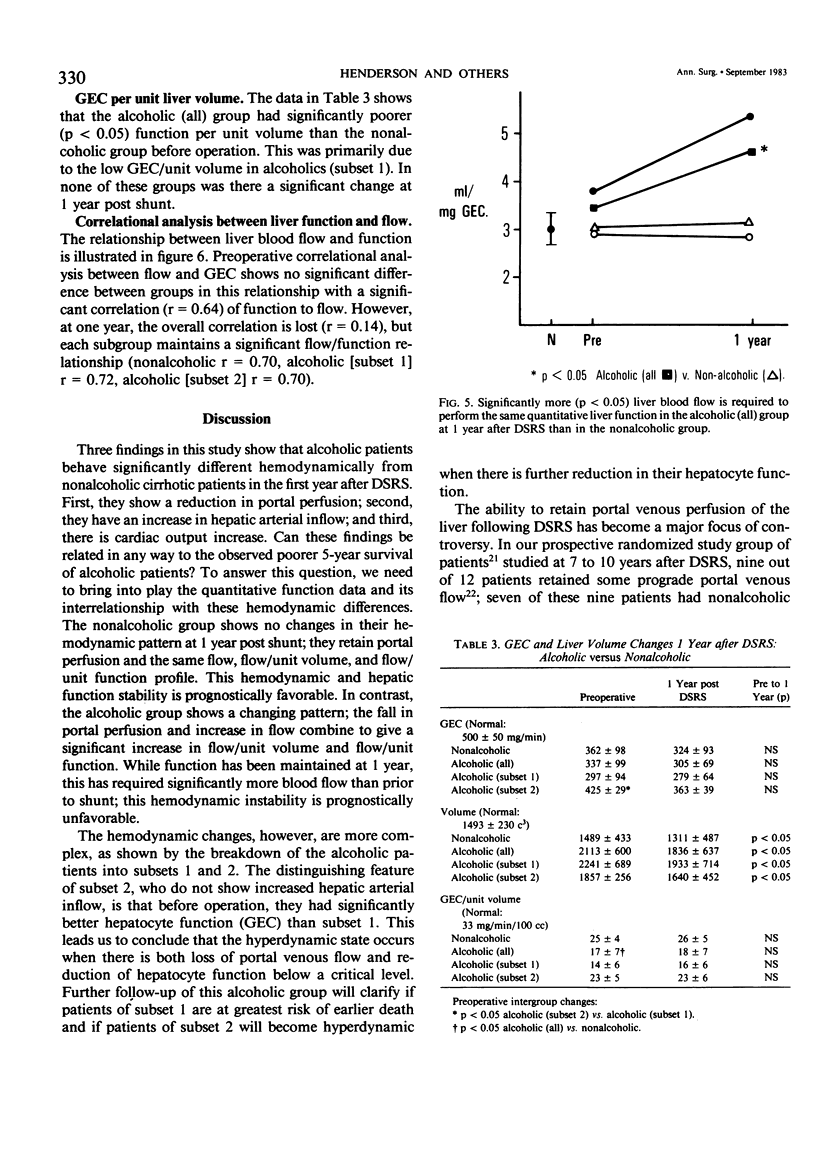
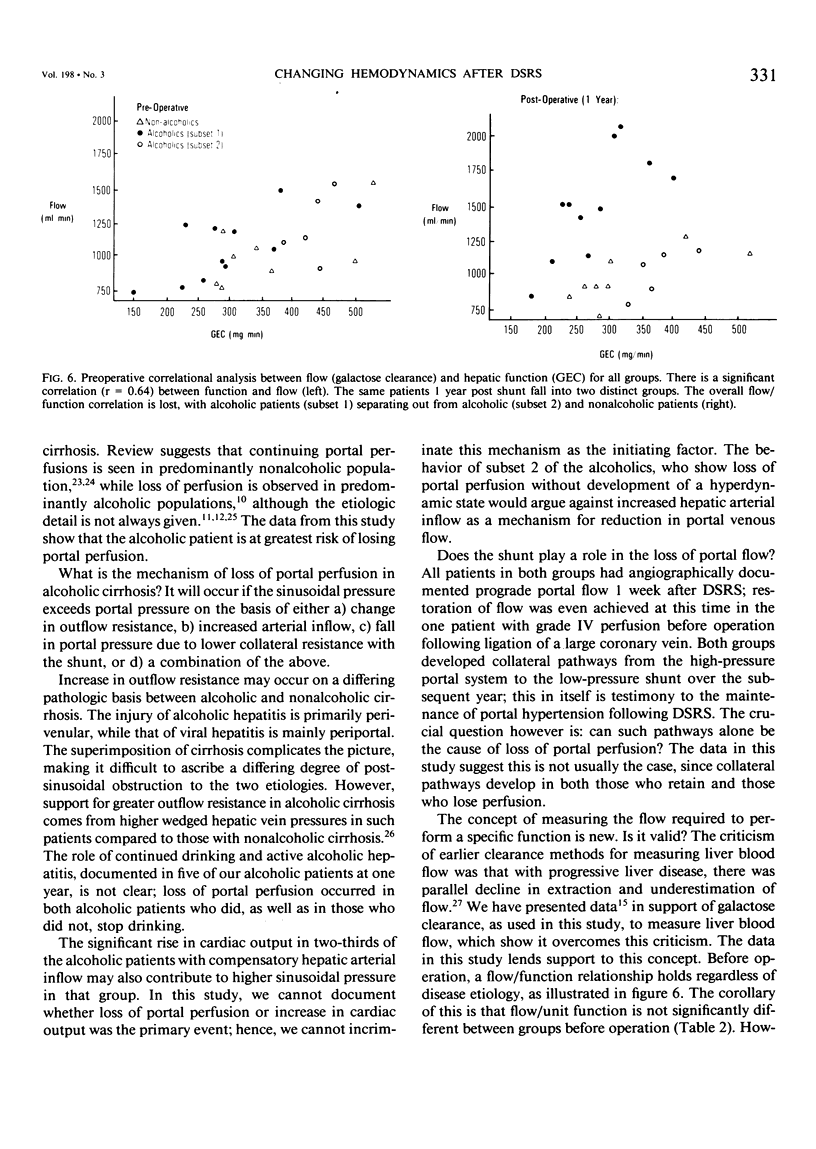
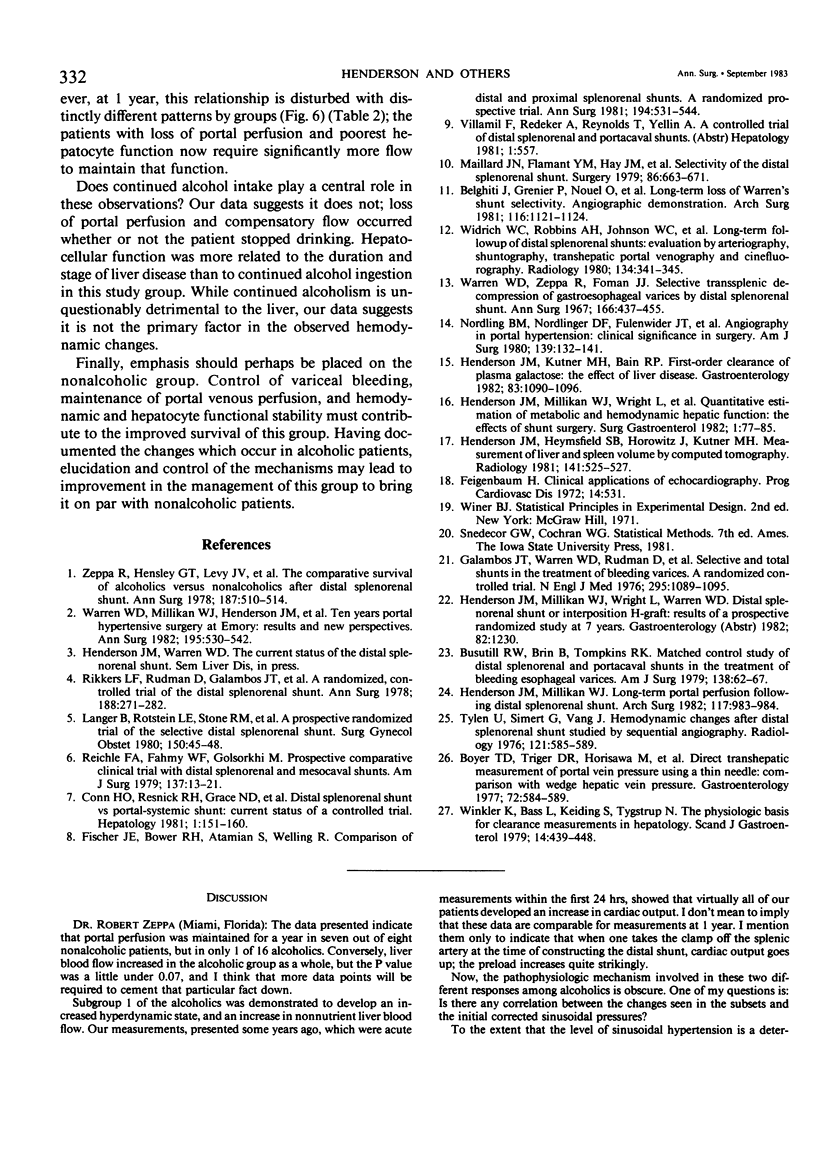
Images in this article
Selected References
These references are in PubMed. This may not be the complete list of references from this article.
- Belghiti J., Grenier P., Nouel O., Nahum H., Fekete F. Long-term loss of Warren's shunt selectivity. Angiographic demonstration. Arch Surg. 1981 Sep;116(9):1121–1124. doi: 10.1001/archsurg.1981.01380210009002. [DOI] [PubMed] [Google Scholar]
- Boyer T. D., Triger D. R., Horisawa M., Redeker A. G., Reynolds T. B. Direct transhepatic measurement of portal vein pressure using a thin needle. Comparison with wedged hepatic vein pressure. Gastroenterology. 1977 Apr;72(4 Pt 1):584–589. [PubMed] [Google Scholar]
- Busuttil R. W., Brin B., Tompkins R. K. Matched control study of distal splenorenal and portacaval shunts in the treatment of bleeding esophageal varices. Am J Surg. 1979 Jul;138(1):62–67. doi: 10.1016/0002-9610(79)90243-5. [DOI] [PubMed] [Google Scholar]
- Conn H. O., Resnick R. H., Grace N. D., Atterbury C. E., Horst D., Groszmann R. J., Gazmuri P., Gusberg R. J., Thayer B., Berk D. Distal splenorenal shunt vs. portal-systemic shunt: current status of a controlled trial. Hepatology. 1981 Mar-Apr;1(2):151–160. doi: 10.1002/hep.1840010211. [DOI] [PubMed] [Google Scholar]
- Feigenbaum H. Clinical applications of echocardiography. Prog Cardiovasc Dis. 1972 May;14(6):531–558. doi: 10.1016/0033-0620(72)90007-2. [DOI] [PubMed] [Google Scholar]
- Fischer J. E., Bower R. H., Atamian S., Welling R. Comparison of distal and proximal splenorenal shunts: a randomized prospective trial. Ann Surg. 1981 Oct;194(4):531–544. doi: 10.1097/00000658-198110000-00016. [DOI] [PMC free article] [PubMed] [Google Scholar]
- Galambos J. T., Warren W. D., Rudman D., Smith R. B., 3rd, Salam A. A. Selective and total shunts in the treatment of bleeding varices. A randomized controlled trial. N Engl J Med. 1976 Nov 11;295(20):1089–1095. doi: 10.1056/NEJM197611112952001. [DOI] [PubMed] [Google Scholar]
- Henderson J. M., Heymsfield S. B., Horowitz J., Kutner M. H. Measurement of liver and spleen volume by computed tomography. Assessment of reproducibility and changes found following a selective distal splenorenal shunt. Radiology. 1981 Nov;141(2):525–527. doi: 10.1148/radiology.141.2.6974875. [DOI] [PubMed] [Google Scholar]
- Henderson J. M., Kutner M. H., Bain R. P. First-order clearance of plasma galactose: the effect of liver disease. Gastroenterology. 1982 Nov;83(5):1090–1096. [PubMed] [Google Scholar]
- Henderson J. M., Millikan W. J., Jr Long-term portal perfusion following distal splenorenal shunt. Arch Surg. 1982 Jul;117(7):983–984. doi: 10.1001/archsurg.1982.01380310089029. [DOI] [PubMed] [Google Scholar]
- Langer B., Rotstein L. E., Stone R. M., Taylor B. R., Patel S. C., Blendis L. M., Colapinto R. F. A prospective randomized trial of the selective distal splenorenal shunt. Surg Gynecol Obstet. 1980 Jan;150(1):45–48. [PubMed] [Google Scholar]
- Maillard J. N., Flamant Y. M., Hay J. M., Chandler J. G. Selectivity of the distal splenorenal shunt. Surgery. 1979 Nov;86(5):663–671. [PubMed] [Google Scholar]
- Nordlinger B. M., Nordlinger D. F., Fulenwider J. T., Millikan W. J., Sones P. J., Kutner M., Steele R., Bain R., Warren W. D. Angiography in portal hypertension: clinical significance in surgery. Am J Surg. 1980 Jan;139(1):132–141. doi: 10.1016/0002-9610(80)90242-1. [DOI] [PubMed] [Google Scholar]
- Reichle F. A., Fahmy W. F., Golsorkhi M. Prospective comparative clinical trial with distal splenorenal and mesocaval shunts. Am J Surg. 1979 Jan;137(1):13–21. doi: 10.1016/0002-9610(79)90004-7. [DOI] [PubMed] [Google Scholar]
- Rikkers L. F., Rudman D., Galambos J. T., Fulenwider J. T., Millikan W. J., Kutner M., Smith R. B., 3rd, Salam A. A., Sones P. J., Jr, Warren W. D. A randomized, controlled trial of the distal splenorenal shunt. Ann Surg. 1978 Sep;188(3):271–282. doi: 10.1097/00000658-197809000-00002. [DOI] [PMC free article] [PubMed] [Google Scholar]
- Tylén U., Simert G., Vang J. Hemodynamic changes after distal splenorenal shunt studied by sequential angiography. Radiology. 1976 Dec;121(3 Pt 1):585–589. doi: 10.1148/121.3.585. [DOI] [PubMed] [Google Scholar]
- Warren W. D., Millikan W. J., Jr, Henderson J. M., Wright L., Kutner M., Smith R. B., 3rd, Fulenwider J. T., Salam A. A., Galambos J. T. Ten years portal hypertensive surgery at Emory. Results and new perspectives. Ann Surg. 1982 May;195(5):530–542. doi: 10.1097/00000658-198205000-00002. [DOI] [PMC free article] [PubMed] [Google Scholar]
- Warren W. D., Zeppa R., Fomon J. J. Selective trans-splenic decompression of gastroesophageal varices by distal splenorenal shunt. Ann Surg. 1967 Sep;166(3):437–455. doi: 10.1097/00000658-196709000-00011. [DOI] [PMC free article] [PubMed] [Google Scholar]
- Widrich W. C., Robbins A. H., Johnson W. C., Nabseth D. C. Long-term follow-up of distal splenorenal shunts: evaluation by arteriography, shuntography, transhepatic portal venography, and cinefluorography. Radiology. 1980 Feb;134(2):341–345. doi: 10.1148/radiology.134.2.7352211. [DOI] [PubMed] [Google Scholar]
- Winkler K., Bass L., Keiding S., Tygstrup N. The physiologic basis for clearance measurements in hepatology. Scand J Gastroenterol. 1979;14(4):439–448. [PubMed] [Google Scholar]
- Zeppa R., Hensley G. T., Levi J. U., Bergstresser P. R., Hutson D. G., Sr, Livingstone A. S., Schiff E. R., Fink P. The comparative survivals of alcoholics versus nonalcoholics after distal splenorenal shunt. Ann Surg. 1978 May;187(5):510–514. doi: 10.1097/00000658-197805000-00008. [DOI] [PMC free article] [PubMed] [Google Scholar]




